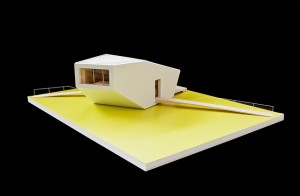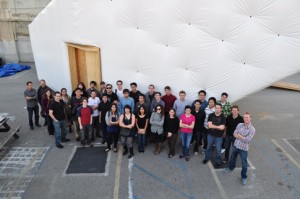CHIP House Takes Design to Different Heights (Literally)
Friday, May 13, 2011By April Saylor
Editor’s Note: This entry has been cross-posted from DOE’s Energy Blog.
In honor of the U.S. Department of Energy Solar Decathlon—which challenges 20 collegiate teams to design, build, and operate solar-powered houses that are cost-effective, energy-efficient, and attractive—we are profiling each of the 20 teams participating in the competition.
The students from the Southern California Institute of Architecture and California Institute of Technology, otherwise known as the SCI-Arc/Caltech team, have teamed up to take an interesting approach to the design of their Solar Decathlon house. Unlike the other houses we’ve profiled, CHIP—which stands for Compact House Infinite Possibilities—looks nothing like a traditional home from the outside, but if all goes as planned, it will achieve energy balance for its occupants.

A model of the SCI-Arc/Caltech team’s CHIP house. (Credit: All Commercial Photography/U.S.
Department of Energy Solar Decathlon)
In what can only be described as a truly “out of the box” approach to the design of the house (pun intended), the SCI-Arc/Caltech team has wrapped the polygonal house in a “skin” that acts as what the team refers to as “outsulation.” This skin is a system of cellulose-filled batts fastened in layers to the outside surface of the roof (underneath the house’s 235-W photovoltaic panels) and exterior walls. This forms a shell, which is wrapped in airtight and water-resistant, architectural-grade, polymer-coated vinyl.
Inside the house, the team has designed a stepped interior, which is divided into a series of platforms terraced upward and inward from most public to most private. The CHIP team is taking its house to new levels—the top and outermost of which serves as the bedroom, where upon awakening the occupant experiences a downhill progression via each level, which are bed/groom/dress/eat/live/work, and then backward in the evening.
In addition to the solar panels on the roof of the house, CHIP is filled with technologies that reduce its energy footprint. One innovative technology inside the house is the thermal integration between the HVAC heat pump, which extracts heat from the interior of the house, and the domestic hot water heat pump, which dumps heat into hot water. By using the waste heat from the air-source heat pump to heat hot water, the team says the house will see “tremendous energy savings while fully satisfying air conditioning and hot water demands.”

The SCI-Arc/Caltech team stands in front of CHIP. (Courtesy of the SCI-Arc/Caltech team)
Other energy-saving technologies include a lighting strategy that takes full advantage of natural sunlight through solar tubes and light louvers and uses energy-saving LEDs and CFLs during nighttime hours. CHIP also has a state-of-the-art home automation system that is able to monitor every watt of electricity used by the house and then visually communicate the information to its occupants. CHIP is even connected to the Internet, which means the house can receive weather-forecast information, which allows it to predict cloudy skies and conserve power generated by its solar panels during peak sunlight hours. The team says this system plays a central role in “optimizing the behavior of the house” and is able to “control operation of the active thermal mass, shutting down appliances or lights that are no longer used, and gives the occupants an instant understanding of their energy use and, in turn, their energy bill.”
The CHIP team held a groundbreaking ceremony April 2 at the SCI-Arc campus in Los Angeles and since then has kept busy with various fundraising and awareness events, construction of the home, and further design elements—all while keeping up with a regular course schedule.
April Saylor is an online content producer and contractor to the Department of Energy Office of Public Affairs.
Tags: SCI-Arc/Caltech, Solar Decathlon, Solar Decathlon 2011, Teams
